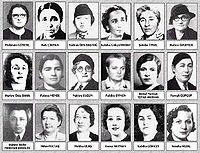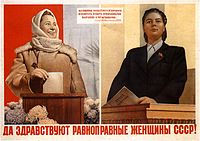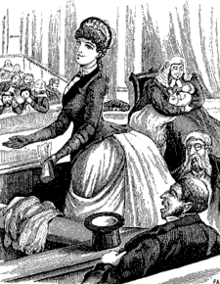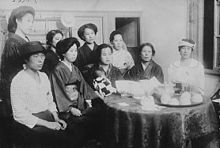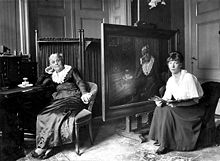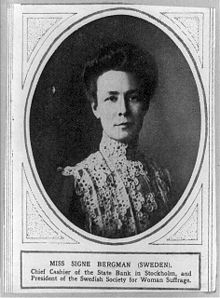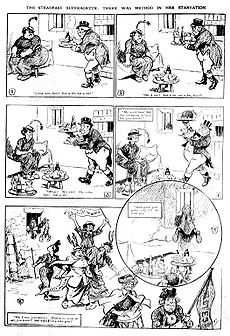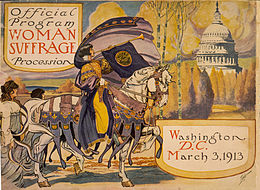- Women's suffrage
-
Women's suffrage or woman suffrage[1] is the right of women to vote and to run for office. The expression is also used for the economic and political reform movement aimed at extending these rights to women[2] and without any restrictions or qualifications such as property ownership, payment of tax, or marital status. The movement's modern origins can be attributed to late-18th century France, although full suffrage did not come to France or the French-speaking Canadian province of Quebec. Limited voting rights were gained by some women in Sweden, Britain, and some western U.S. states in the 1860s. In 1893, the British colony of New Zealand became the first self-governing nation to extend the right to vote to all adult women, and the women of the nearby colony of South Australia achieved the same right in 1895 but became the first to obtain also the right to stand (run) for Parliament (women did not win the right to run for the New Zealand legislature until 1919).[3][4] The first European country to introduce women's suffrage was the Grand Principality of Finland and that country, then a part of the Russian Empire with autonomous powers, produced the world's first female members of parliament as a result of the 1907 parliamentary elections.
Women's suffrage has generally been recognized after political campaigns to obtain it were waged. In many countries it was granted before universal suffrage. Women’s suffrage is explicitly stated as a right under the Convention on the Elimination of All Forms of Discrimination Against Women, adopted by the United Nations in 1979.
Contents
History
In medieval France and several other European countries, voting for city and town assemblies and meetings was open to the heads of households. In Sweden, conditional woman suffrage was granted during the age of liberty between 1718 and 1771, when taxpaying women listed in the guilds as professionals were allowed to vote.[5]
Women were entitled to vote in the Corsican Republic in 1755 whose Constitution stipulated a national representative assembly elected by all inhabitants over the age of 25, both women (if unmarried or widowed) and men.[citation needed] Women's suffrage was ended when France annexed the island in 1769. The modern movement for women's suffrage originated in France in the 1780s and 1790s, where Antoine Condorcet and Olympe de Gouges advocated women's suffrage in national elections.
In 1756, Lydia Chapin Taft became the first legal woman voter in colonial America. This occurred under British rule in the Massachusetts Colony.[6] This was in a New England town meeting and she voted on at least three occasions in Uxbridge, Massachusetts.[7]
Women in New Jersey could vote (with the same property qualifications as for men, although, since married women did not own property in their own right, only unmarried women and widows qualified) under the state constitution of 1776, where the word "inhabitants" was used without qualification of sex or race. New Jersey women, along with "aliens...persons of color, or negroes," lost the vote in 1807, when the franchise was restricted to white males, ostensibly, to combat electoral fraud by simplifying the conditions for eligibility.
In the 1792 elections in Sierra Leone, all heads of household—one-third of whom were African women—could vote.[8]
The female descendants of the Bounty mutineers who lived on Pitcairn Islands could vote from 1838, and this right transferred with their resettlement to Norfolk Island (now an Australian external territory) in 1856.[4] Various countries, colonies and states granted restricted women's suffrage in the latter half of the nineteenth century, starting with South Australia in 1861.
The seed for the first Woman's Rights Convention was planted in 1840, when Elizabeth Cady Stanton met Lucretia Mott at the World Anti-Slavery Convention in London, the conference that refused to seat Mott and other women delegates from America because of their sex. In 1851, Stanton met temperance worker Susan B. Anthony, and shortly the two would be joined in the long struggle to secure the vote for women. In 1868 Anthony encouraged working women from the printing and sewing trades in New York, who were excluded from men's trade unions, to form Workingwomen's Associations. As a delegate to the National Labor Congress in 1868 Anthony persuaded the committee on female labor to call for votes for women and equal pay for equal work, although the men at the conference deleted the reference to the vote.[9]
Women in the Wyoming Territory voted as of (1869). Other possible contenders for first "country" to grant female suffrage include the Corsican Republic, the Isle of Man (1881), the Pitcairn Islands, and Franceville, but some of these had brief existences as independent states and others were not clearly independent.
The 1871 Paris Commune recognized women's right to vote, but with its fall women were again deprived of the right, which would only be recognized again in July 1944 by Charles de Gaulle (at that time most of France—including Paris—was under Nazi occupation; Paris was liberated the following month). The Pacific colony of Franceville, declaring independence in 1889, became the first self-governing nation to adopt universal suffrage without distinction of sex or color;[10] however, it soon came back under French and British colonial rule.
In 1881 the Isle of Man, an internally self-governing dependent territory of the British Crown, enfranchised women property owners and delivered the first installment of women’s right to vote in parliamentary elections within the British Isles.[4]
Of currently existing independent countries, New Zealand was the first to acknowledge women's right to vote in 1893 when it was a self-governing British colony.[11] Unrestricted women's suffrage in terms of voting rights (women were not initially permitted to stand for election) was adopted in New Zealand in 1893. Following a successful movement led by Kate Sheppard, the women's suffrage bill was adopted mere weeks before the general election of that year. The women of the British protectorate of Cook Islands obtained the same right soon after and beat New Zealand's women to the polls in 1893.[12]
The self-governing British colony of South Australia enacted universal suffrage and enabled women to stand for the colonial parliament in 1895.[13] The Commonwealth of Australia federated in 1901, with women voting and standing for office in some states. The Australian Federal Parliament extended voting rights to all adult women for Federal elections from 1902 (with the exception of Aboriginal women in some states).[14]
The first European country to introduce women's suffrage was the Grand Duchy of Finland. Amidst the administrative reforms following the 1905 uprising, Finnish women's demand for both the right to vote (universal and equal suffrage) and the right to stand for election were met in 1906. The world's first female members of parliament were also Finnish, when on 1907, 19 women took up their places in the Parliament of Finland as a result of the 1907 parliamentary elections.
In the years before World War I, women in Norway (1913) and Denmark (1915) also won the right to vote, as did women in the remaining Australian states. Near the end of the war, Canada, Soviet Russia, Germany and Poland also recognized women's right to participate in the elective franchise. British women over 30 had the vote in 1918, Dutch women in 1919, and American women won the vote in 1920. Women in Turkey won voting rights in 1926. In 1928, British women won suffrage on the same terms as men, that is, for persons 21 years old and older. One of the most recent jurisdictions to acknowledge women's full right to vote was Bhutan in 2008 (its first national elections).[15]
Voting rights for women were introduced into international law by the United Nations' Human Rights Commission, whose elected chair was Eleanor Roosevelt. In 1948, the United Nations adopted the Universal Declaration of Human Rights, that the Commission wrote. As stated in Article 21 "(1) Everyone has the right to take part in the government of his country, directly or through freely chosen representatives. (3) The will of the people shall be the basis of the authority of government; this will shall be expressed in periodic and genuine elections which shall be by universal and equal suffrage and shall be held by secret vote or by equivalent free voting procedures."
Suffrage movements
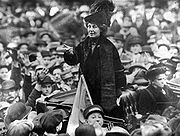 After selling her home, British activist Emmeline Pankhurst travelled constantly, giving speeches throughout Britain and the United States. One of her most famous speeches, Freedom or death, was delivered in Connecticut in 1913.
After selling her home, British activist Emmeline Pankhurst travelled constantly, giving speeches throughout Britain and the United States. One of her most famous speeches, Freedom or death, was delivered in Connecticut in 1913.
The suffrage movement was a very broad one which encompassed women and men with a very broad range of views. One major division, especially in Britain, was between suffragists, who sought to create change constitutionally, and suffragettes, led by iconic English political activist Emmeline Pankhurst, who in 1903 formed the more militant Women's Social and Political Union.[16] Pankhurst would not be satisfied with anything but action on the question of women's enfranchisement, with "deeds, not words" the organisation's motto.[17] There was also a diversity of views on a 'woman's place'. Some who campaigned for women's suffrage felt that women were naturally kinder, gentler, and more concerned about weaker members of society, especially children. It was often assumed that women voters would have a civilizing effect on politics and would tend to support controls on alcohol, for example. Societies believed that although a woman's place was in the home, she should be able to influence laws which impacted upon that home. Other campaigners felt that men and women should be equal in every way and that there was no such thing as a woman's 'natural role'. There were also differences in opinion about other voters. Some campaigners felt that all adults were entitled to a vote, whether rich or poor, male or female, and regardless of race. Others saw women's suffrage as a way of canceling out the votes of lower class or non-white men.
Table of international women's suffrage
Main article: Timeline of women's suffrageDate listed is the first date women were allowed to participate (by voting) in elections, not the date that women were granted universal suffrage without restrictions.
Note: The table can be sorted alphabetically or chronologically using the
 icon.
icon.Country Year Voting age  Kingdom of Afghanistan
Kingdom of Afghanistan1963 18 years  Principality of Albania
Principality of Albania1920 18 years  Algeria
Algeria1962 18 years  Andorra
Andorra1970 18 years  People's Republic of Angola
People's Republic of Angola1975 18 years  British Leeward Islands (Today: Antigua and Barbuda, British Virgin Islands, Montserrat, Saint Kitts and Nevis, Anguilla)
British Leeward Islands (Today: Antigua and Barbuda, British Virgin Islands, Montserrat, Saint Kitts and Nevis, Anguilla)1951 18 years  Argentina
Argentina1947[18] 18 years  Armenia
Armenia1917 (by application of the Russian legislation)
1919 March (by adoption of its own legislation)[19]18 years (currently)
20 years (initially) Aruba
Arubaa 18 years  Australia
Australia1902 18 years  German Austria
German Austria1919 16 years (since 2007)
20 years (initially) Azerbaijan Democratic Republic
Azerbaijan Democratic Republic1918 18 years  Bahamas
Bahamas1960 18 years  Bahrain
Bahrain2002 18 years  Bangladesh
Bangladesh1972 (since independence) 18 years  Barbados
Barbados1950 18 years  British Windward Islands (Today: Grenada, St Lucia, St Vincent and the Grenadines, Dominica
British Windward Islands (Today: Grenada, St Lucia, St Vincent and the Grenadines, Dominica1951 18 years  Belarusian People's Republic
Belarusian People's Republic1919 18 years  Belgium
Belgium1919/1948(b) 18 years  British Honduras (Today: Belize)
British Honduras (Today: Belize)1954 18 years  Dahomey (Today: Benin)
Dahomey (Today: Benin)1956 18 years  Bermuda
Bermuda1944 18 years  Bhutan
Bhutan1953 18 years  Bolivia
Bolivia1938 18 years  Botswana
Botswana1965 18 years  Brazil
Brazil1931 16 years  Brunei
Brunei1959 18 years (village elections only)  Kingdom of Bulgaria
Kingdom of Bulgaria1938 18 years  Upper Volta (Today: Burkina Faso)
Upper Volta (Today: Burkina Faso)1958 18 years  Burma
Burma1922 18 years  Burundi
Burundi1961 18 years  Kingdom of Cambodia
Kingdom of Cambodia1955 18 years  British Cameroons (Today: Cameroon)
British Cameroons (Today: Cameroon)1946 20 years  Canada
Canada1917 18 years  Cape Verde
Cape Verde1975 18 years  Cayman Islands
Cayman Islandsa 18 years  Central African Republic
Central African Republic1986 21 years  Chad
Chad1958 18 years  Chile
Chile1934 18 years (currently)
25 years initially, able to read and write (local elections only) China
China1947 18 years  Colombia
Colombia1954 18 years  Comoros
Comoros1956 18 years  Zaire (Today: Democratic Republic of the Congo)
Zaire (Today: Democratic Republic of the Congo)1967 18 years  Congo, Republic of the
Congo, Republic of the1963 18 years  Cook Islands
Cook Islands1893 18 years  Costa Rica
Costa Rica1949 18 years  Côte d'Ivoire
Côte d'Ivoire1952 19 years  Cuba
Cuba1934 16 years  Cyprus
Cyprus1960 18 years  Czechoslovakia (Today: Czech Republic, Slovakia)
Czechoslovakia (Today: Czech Republic, Slovakia)1920 18 years  Denmark (Then including Iceland)
Denmark (Then including Iceland)1915 18 years  Djibouti
Djibouti1946 18 years  Dominican Republic
Dominican Republic1942 18 years  Ecuador
Ecuador1929 18 years  Egypt
Egypt1956 18 years  El Salvador
El Salvador1939 18 years  Equatorial Guinea
Equatorial Guinea1963 18 years  Estonia
Estonia1917 18 years  Ethiopia (Then including Eritrea)
Ethiopia (Then including Eritrea)1955 18 years  Falkland Islands
Falkland Islandsa 18 years  Fiji
Fiji1963 21 years  Finland
Finland1906 18 years  France
France1944 18 years  French Polynesia
French Polynesiaa 18 years  Gabon
Gabon1956 21 years  Gambia, The
Gambia, The1960 18 years  Democratic Republic of Georgia
Democratic Republic of Georgia1918 18 years  Germany
Germany1918 18 years  Ghana
Ghana1954 18 years  Gibraltar
Gibraltara 18 years  Greece
Greece1930 (Local Elections, Literate Only), 1952 (Unconditional) 18 years (since 1952), 30 years (in 1930)  Greenland
Greenlanda 18 years  Guam
Guama 18 years  Guatemala
Guatemala1946 18 years  Guernsey
Guernseya 18 years  Guinea
Guinea1958 18 years  Guinea-Bissau
Guinea-Bissau1977 18 years  Guyana
Guyana1953 18 years  Haiti
Haiti1950 18 years  Honduras
Honduras1955 18 years  Hong Kong
Hong Kong1949 18 years  Hungarian Democratic Republic
Hungarian Democratic Republic1918 18 years  India
India1947 (Since the state's inception) 18 years  Indonesia
Indonesia1937 (for Europeans only), 1945 17 years (married persons regardless of age)  Iran
Iran1963 18 years, was 15  Iraq
Iraq1980 18 years  Ireland
Ireland1918 18 years  Isle of Man
Isle of Man1881 16 years  Israel
Israel1948 (Since the state's inception) 18 years  Italy
Italy1946 18 years (except in senatorial elections, where minimum age is 25)  Jamaica
Jamaica1944 18 years  Japan
Japan1947 20 years  Jersey
Jerseya 16 years  Jordan
Jordan1974 18 years  Kazakh SSR
Kazakh SSR1924 18 years  Kenya
Kenya1963 18 years  Kiribati
Kiribati1967 18 years  Korea, North
Korea, North1946 17 years  Korea, South
Korea, South1948 19 years  Kuwait
Kuwait2005 21 years  Kyrgyz SSR
Kyrgyz SSR1918 18 years  Kingdom of Laos
Kingdom of Laos1958 18 years  Latvia
Latvia1917 18 years  Lebanon
Lebanon1943 (with proof of elementary education). 1952 (proof not necessary) 21 years  Lesotho
Lesotho1965 18 years  Liberia
Liberia1946 18 years  Kingdom of Libya
Kingdom of Libya1964 18 years  Liechtenstein
Liechtenstein1984 18 years  Lithuania
Lithuania1917 18 years  Luxembourg
Luxembourg1919 18 years  Macau
Macaua 18 years  Madagascar
Madagascar1959 18 years  Malawi
Malawi1961 18 years  Federation of Malaya (Today: Malaysia)
Federation of Malaya (Today: Malaysia)1957 21 years  Maldives
Maldives1932 21 years  Mali
Mali1956 18 years  Malta
Malta1947 18 years  Marshall Islands
Marshall Islands1979 18 years  Mauritania
Mauritania1961 18 years  Mauritius
Mauritius1956 18 years  Mexico
Mexico1947 18 years  Micronesia, Federated States of
Micronesia, Federated States of1979 18 years  Moldova
Moldova1918 18 years  Monaco
Monaco1962 18 years  Mongolian People's Republic
Mongolian People's Republic1924 18 years  Morocco
Morocco1963 18 years  People's Republic of Mozambique
People's Republic of Mozambique1975 18 years  Namibia
Namibia1989 18 years  Nauru
Nauru1968 20 years  Nepal
Nepal1951 18 years  Netherlands
Netherlands1919 18 years  New Zealand
New Zealand1893 18 years  Nicaragua
Nicaragua1955 16 years  Niger
Niger1948 18 years  Nigeria
Nigeria1958 18 years  Norway
Norway1913 18 years  Oman
Oman2003 21 years  Pakistan
Pakistan1947 (Since the state's inception) 18 years  Palau
Palau1979 18 years  Panama
Panama1941 18 years  Papua New Guinea
Papua New Guinea1964 18 years  Paraguay
Paraguay1961 18 years  Peru
Peru1955 18 years  Philippines
Philippines1937 18 years  Pitcairn Islands
Pitcairn Islands1838 18 years  Poland
Poland1917 18 years  Portugal
Portugal1931 18 years  Puerto Rico
Puerto Rico1929 18 years  Qatar
Qatar1997 18 years  Kingdom of Romania
Kingdom of Romania1938 18 years  Russian Provisional Government
Russian Provisional Government1917 18 years (currently)
20 years (initially, for city dumas)[20]
21 year (initially, for RCA)[21] Rwanda
Rwanda1961 18 years  Saint Helena
Saint Helenaa a  Samoa
Samoaa 21 years  San Marino
San Marino1959 18 years  São Tomé and Príncipe
São Tomé and Príncipe1975 18 years  Saudi Arabia
Saudi Arabia2015 (expected) 21 years  Senegal
Senegal1945 18 years  Seychelles
Seychelles1948 17 years  Sierra Leone
Sierra Leone1961 18 years  Singapore
Singapore1947 21 years  Solomon Islands
Solomon Islands1974 21 years  Somalia
Somalia1956 18 years  South Africa
South Africa1930 (White); 1968 (Coloured); 1984 (Indian); 1994 (Black) 18 years (21 years initially until lowered in 1960)  Spain
Spain1931 18 years  Ceylon (Today: Sri Lanka)
Ceylon (Today: Sri Lanka)1931 18 years  Sudan
Sudan1964 17 years  Dutch Guiana (Today: Suriname)
Dutch Guiana (Today: Suriname)1948 18 years  Swaziland
Swaziland1968 18 years  Sweden
Sweden1921 18 years  Switzerland
Switzerland1971 18 years  Syria
Syria1949 18 years  Taiwan
Taiwan1947 20 years  Tajik SSR
Tajik SSR1924 18 years  Tanzania
Tanzania1959 18 years  Thailand
Thailand1932 18 years  Timor-Leste
Timor-Leste1976 17 years  Togo
Togo1945 18 years  Tonga
Tonga1960 21 years  Trinidad and Tobago
Trinidad and Tobago1946 18 years  Tunisia
Tunisia1959 18 years  Turkey
Turkey1930 (for local elections), 1934 (for national elections) 18 years  Turkmen SSR
Turkmen SSR1924 18 years  Tuvalu
Tuvalu1967 18 years  Uganda
Uganda1962 18 years  Ukrainian SSR
Ukrainian SSR1919 18 years  United Arab Emirates
United Arab Emirates2006 a  United Kingdom (Then including Ireland)
United Kingdom (Then including Ireland)1918 and 1928 18 years, was 30 and then 21 years  United States
United States1920 18 years  Uruguay
Uruguay1927 18 years  Uzbek SSR
Uzbek SSR1938 18 years  Vanuatu
Vanuatu1975 18 years  Venezuela
Venezuela1946 18 years  Vietnam
Vietnam1946 18 years  South Yemen
South Yemen1967 18 years  Zambia
Zambia1962 18 years  Southern Rhodesia (Today: Zimbabwe)
Southern Rhodesia (Today: Zimbabwe)1919 21 years  Yugoslavia (Today: Serbia, Montenegro, Croatia, Slovenia, Bosnia-Herzegovina, Macedonia)
Yugoslavia (Today: Serbia, Montenegro, Croatia, Slovenia, Bosnia-Herzegovina, Macedonia)1945 18 years Note:
- (a) Data unavailable
- (b) Was granted in the constitution in 1919, for communal voting. Suffrage for the provincial councils and the national parliament only came in 1948.
Women's suffrage by country
Asia
Indonesia
In the first half of the twentieth century, Indonesia (pre-independence era) was one of the slowest moving countries to gain women’s suffrage. They began their fight in 1905 by introducing municipal councils that included some members elected by a restricted district. Voting rights only went to males that could read and write, which excluded many non-European males. At the time, the literacy rate for males was 11% and for females 2%. The main group who pressured the Indonesian government for women’s suffrage was the Dutch Vereeninging voor Vrouwenkiesrecht (VVV-Women’s Suffrage Association) which was founded in the Netherlands in 1894. They tried to attract Indonesian membership, but had very limited success because the leaders of the organization had little skill in relating to even the educated class of the Indonesians. When they eventually did connect somewhat with women, they failed to sympathize with them and thus ended up alienating many well-educated Indonesians. In 1918 the colony gained its first national representative body called the Volksraad, which still excluded women in voting. In 1935, the colonial administration used its power of nomination to appoint a European woman to the Volksraad. In 1938, the administration introduced the right of women to be elected to urban representative institution, which resulted in some Indonesian and European women entering municipal councils. Eventually, the law became that only European women and municipal councils could vote,[clarification needed] which excluded all other women and local councils. September 1941 was when this law was amended and the law extended to women of all races by the Volksraad. Finally, in November 1941, the right to vote for municipal councils was granted to all women on a similar basis to men (with property and educational qualifications).[22] There are a lot of women that supports the rights for women. The famous one is Raden Ajeng Kartini. She is also famous for her quote, "Habis Gelap, Terbitlah Terang" or in English, "After Dark, Comes the Light". It means that after bad days or dark days, there will always be hope everything including the success of the Women's Suffrage. Raden Ajeng Kartini did succeed. The other women that also fights for women's right also succeed. Raden Ajeng Kartini is so famous, Indonesians made a special date just for her, Hari Kartini, or Kartini's Day on the 21st of April, which is Kartini's birthday.
Iran
In 1963, a referendum overwhelmingly approved by voters gave women the right to vote, a right previously denied to them under the Iranian Constitution of 1906 pursuant to Chapter 2, Article 3.
Japan
Main article: Women's suffrage in JapanAlthough women were allowed to vote in some counties in 1880, women's suffrage was enacted at a national level in 1945.[23]
Kuwait
Main article: Kuwaiti female suffrageWomen's suffrage in Kuwait was recognized in an amendment to electoral law on May 17, 2005.[24]
Saudi Arabia
In late September, 2011, King Abdullah bin Abdulaziz al-Saud declared that women would be able to vote and run for office starting in 2015. The franchise will apply to the only (semi-)elected bodies in the kingdom, the municipal councils. Half of the seats on municipal councils are elective, and the councils have few powers. [25] The council elections have been held since 2005 (the first time they were held before that was the 1960s).[26][27] for the first time since the 1960s.[citation needed] The King also declared that women would be eligible to be appointed to the Shura Council, an unelected body that issues advisory opinions on national policy.[28] '"This is great news," said Saudi writer and women's rights activist Wajeha al-Huwaider. "Women's voices will finally be heard. Now it is time to remove other barriers like not allowing women to drive cars and not being able to function, to live a normal life without male guardians."' Robert Lacey, author of two books about the kingdom, said, "This is the first positive, progressive speech out of the government since the Arab Spring.... First the warnings, then the payments, now the beginnings of solid reform." The king made the announcement in a five-minute speech to the Shura Council.[27]
Sri Lanka
Sri Lanka (at that time Ceylon) was one of the first Asian countries to allow voting rights to women over the age of 21 without any restrictions. Since then, women have enjoyed a significant presence in the Sri Lankan political arena. The zenith of this favourable condition to women has been the 1960 July General Elections, in which Ceylon elected the world's first woman Prime Minister, Mrs. Sirimavo Bandaranaike. Her daughter, Mrs. Chandrika Kumaratunga also became the Prime Minister later in 1994, and the same year she was elected as the Executive President of Sri Lanka, making her the fourth woman in the world to hold the portfolio.
Africa
Southern Rhodesia
Southern Rhodesian women won the vote in 1919 and Ethel Tawse Jollie (1875–1950) was elected to the Southern Rhodesia legislature 1920-1928, the first woman to sit in any national Commonwealth Parliament outwith Westminster. The influx of women settlers from the United Kingdom and the British Dominions proved a decisive factor in the 1922 referendum that rejected annexation by a South Africa increasingly under the sway of traditionalist Afrikaner Nationalists in favour of Rhodesian Home Rule or 'responsible government'.[29] Only 51 black Rhodesians qualified for the vote in 1923 (based upon property, assets, income and literacy) and it is unclear when the first black woman qualified for the vote.
Europe
Austria
After the revolution in 1848, the right to vote was bound to the ownership of property and thus paying of taxes. While it was also bound to being male, a small number of privileged women who owned property were actually allowed to vote as a result. In 1889 this "loophole" was closed in Lower Austria, which led some to mobilise for the struggle for political rights and the right to vote for women.
It was only after the breakdown of the Habsburg monarchy, that the new Austria would grant the general, equal, direct and secret right to vote to all citizens, regardless of sex in 1919. [30]
Belgium
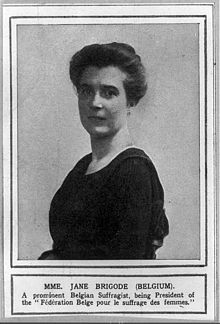 Jane Brigode, Belgian suffragist, around 1910.
Jane Brigode, Belgian suffragist, around 1910.
After a revision of the constitution in 1921 the general right to vote was introduced according to the "one man, one vote" principle. Women obtained voting rights at the municipal level. As an exception, widows of World War I were allowed to vote at the national level as well. The introduction of women's suffrage was already put onto the agenda at the time, by means of including an article in the constitution that allowed approval of women's suffrage by special law. This happened no sooner than after World War II, in 1948. In Belgium, people are obliged to appear at the polling station, however voting in itself is not mandatory.
Czech Republic
In the former Bohemia, taxpaying women and women in "learned profession" where allowed to vote by proxy and made eligible to the legislative body in 1864.[31] The general public obtained the right to vote and be elected, based on age but regardless of sex, when Czechoslovakia was established in 1918.
Denmark
In Denmark women were given the right to vote in municipal elections on April 20, 1909. However it was not until June 5, 1915 that they were allowed to vote in Rigsdag elections.[32]
Finland
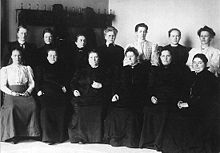 13 of the total of 19 female MPs, who were the first female MPs in the world, elected in Finland's parliamentary elections in 1907.
13 of the total of 19 female MPs, who were the first female MPs in the world, elected in Finland's parliamentary elections in 1907.
Finland was a Swedish province until 1809, signifying that also women in Finland were allowed to vote during the Swedish age of liberty (1718–1771), when suffrage was granted to tax-paying female members of guilds[5]
The predecessor state of modern Finland, The Grand Principality of Finland was part of the Russian Empire from 1809 to 1917 and enjoyed a high degree of autonomy. In 1863, taxpaying women were granted municipal suffrage in the country side, and in 1872, the same reform was given to the cities[31] The Parliament Act in 1906 established the unicameral parliament of Finland and both women and men were given the right to vote and stand for election. Thus Finnish women became the first in the world to have unrestricted rights both to vote and to stand for parliament. In elections the next year, 19 female MPs, first ones in the world, were elected and women have continued to play a central role in the nation's politics ever since. Miina Sillanpää, a key figure in the worker's movement, became the first female minister in 1926.
Finland's first female President Tarja Halonen was voted into office in 2000 and for a second term in 2006. Since the 2011 parliamentary election, women's representation stands at 42,5%. In 2003 Anneli Jäätteenmäki became the first female Prime Minister of Finland, and in 2007 Matti Vanhanen's second cabinet made history as for the first time there were more women than men in the cabinet of Finland (12 vs. 8).
France
Suffrage was extended to women in France by the 21 April 1944 ordinance of the French provisional government.[33][34] The first elections with female participation were the municipal elections of 29 April 1945 and the parliamentary elections of 21 October 1945. "Indigenous Muslim" women in French Algeria had to wait until a 3 July 1958 decree.[35][36]
Germany
In Germany, women's suffrage was granted in the new constitution of the Weimar republic in 1919.
Italy
In Italy, women's suffrage was not introduced following the First World War, but upheld by Socialist and Fascist activists and partly introduced by Benito Mussolini's government in 1925.[37] Following the war, in the 1946 election, all Italians simultaneously voted for the Constituent Assembly and for a referendum about keeping Italy a monarchy or creating a republic instead. The elections weren't held in the Julian March and South Tyrol because they were under UN occupation.
Liechtenstein
In Liechtenstein, women's suffrage was granted via referendum in 1984.[38] Previously, referendums on the issue of women's suffrage had been held in 1968, 1971 and 1973.
Netherlands
The group working for women’s suffrage in the Netherlands was the Dutch Vereeniging voor Vrouwenkiesrecht (Women’s Suffrage Association), founded in 1894. In 1917 Dutch women became electable in national elections, which led to the election of Suze Groeneweg of the SDAP party in the general elections of 1918. On the 15th of May 1919 a new law was drafted to allow women's suffrage without any limitations. The law was passed and the right to vote could be exercised for the first time in the general elections of 1922.
Voting was made mandatory from 1918, which was not lifted until 1970.
Norway
Middle class women could vote for the first time in 1907 (i.e. women coming from families with a certain level of prosperity). Women in general were allowed to vote in local elections from 1910 on, and in 1913 a motion on general suffrage for women was carried unanimously in the Norwegian parliament (Stortinget).
Poland
Poland in its first days after regaining of independence (1918) after the 123 year period of the Partitions of Poland (before 1795 tax-paying females were allowed to take part in political life), allowed voting rights to women, as well as rights to be elected, without any restrictions. Roza Pomerantz-Meltzer was the first woman elected to the Sejm in 1919 as a member of a Zionist party.[39][40]
Portugal
Carolina Beatriz Ângelo was the first Portuguese woman to vote, in 1911, for the Republican Constitutional Parliament. She argued that she was entitled to do so as she was the head of a household. The law was changed some time later, stating that only male heads of households could vote. In 1931, during the Estado Novo regime, women were allowed to vote for the first time, but only if they had a high school or university degree, while men had only to be able to read and write. In 1946, a new electoral law enlarged the possibility of female vote, but still with some differences regarding men. A law from 1968 claimed to establish "equality of political rights for men and women", but a few electoral rights were reserved for men. After the Carnation Revolution, in 1974, women were granted full and equal electoral rights.
Spain
In the Basque provinces of Biscay and Guipúzcoa women who paid a special election tax were allowed to vote and get elected to office till the abolition of the Basque Fueros.[citation needed] Nonetheless the possibility of being elected without the right to vote persisted, hence María Isabel de Ayala was elected mayor in Ikastegieta in 1865. Woman suffrage was officially adopted in 1931 not without the opposition of Margarita Nelken and Victoria Kent, two female MPs (both members of the Republican Radical-Socialist Party), who argued that women in Spain and at that time, were far too immature and ignorant to vote responsibly, thus putting at risk the existence of the Second Republic. During the Franco regime only women that were considered heads of household were allowed to vote; in the "organic democracy" type of elections called "referendums" (Franco's regime was dictatorial) women were allowed to vote.[41] From 1976, during the Spanish transition to democracy women fully exercised the right to vote and be elected to office.
Sweden
During the age of liberty (1718–1771), tax-paying female members of guilds (most often widows), were allowed to vote for over 50 years. Between 1726 and 1742, women took part in 30 percent of elections. New tax regulations made the participation of women in the elections even more extensive from 1743 onward.[5]
The vote was sometimes given through a male representative, which was one of the most prominent reasons cited by those in opposition to female suffrage. In 1758, women were excluded from mayoral and local elections, but continued to vote in national elections. In 1771, women's suffrage was abolished through the new constitution.[5]
In 1862, tax-paying women of legal majority (unmarried women and widows) were again allowed to vote in municipal elections. Thereby, Sweden became the first nation in the world to grant women the right to vote [31] The right to vote in municipal elections applied only to people of legal majority, which excluded married women, as they were juridically under the guardianship of their husbands. In 1884, the suggestion to grant women the right to vote in national elections was initially voted down in Parliament.[42] In 1902, the Swedish Society for Woman Suffrage was founded. A few years later in 1906, the suggestion of women's suffrage was voted down in parliament again.[43] However, the same year, in 1906, also married women were given municipal suffrage. In 1909, women were granted eligibility to municipal councils, and in the following 1910–11 municipal elections, 40 women were elected to different municipal councils, Hanna Lindberg one of them.[43]
Women were active in modern political organisations from the start. Several women reached notable political positions before the suffrage of 1919/21, such as Kata Dahlström, first woman in the Social Democratic executive committee in 1900, as well as Anna Sterky, chairman of the Women's Trade Union 1902–1907. In 1914, Emilia Broomé became the first woman in the legislative assembly.
The right to vote in national elections was not returned to women until 1919, and was practiced again in the election of 1921, for the first time in 150 years.[5] In the election of 1921 more women than men had the right to vote because women got the right just by turning 18 years old wile men had to undergo military service for the right to vote. In a decision 1921 men received the same right as women and this was practiced in the election of 1924.
After the 1921 election, the first women were elected to Swedish Parliament after the suffrage, Kerstin Hesselgren among them. In 1958, Ulla Lindström became the first acting Prime Minister.
Switzerland
Main article: Women's suffrage in SwitzerlandThe Swiss referendum on women's suffrage was held on 1 February 1959. The majority of Switzerland's men voted "no", but in some cantons women obtained the vote.[44] The first Swiss woman to hold political office, Trudy Späth-Schweizer, was elected to the municipal government of Riehen in 1958.[45]
Switzerland was the last Western republic to grant women's suffrage; although women could not vote in the Principality of Liechtenstein (governed under a constitutional monarchy) until 1984.[46] Women did not gain the right to vote in federal elections until 1971.[44] In 1991, following a decision by the Federal Supreme Court of Switzerland, Appenzell Innerrhoden became the last Swiss canton to grant women the vote on local issues.[47]
Turkey
In Turkey women were given the right to vote in municipal elections on March 20, 1930. Women's suffrage was achieved for parliament elections on December 5, 1934 by the constitutional amendment. Turkish women who participated for the parliament elections as a first time on February 8, 1935 obtained 18 seats.
United Kingdom
Main article: Women's suffrage in the United KingdomThe campaign for women's suffrage gained momentum throughout the early part of the nineteenth century as women became increasingly politically active, particularly during the campaigns to reform suffrage in the United Kingdom. John Stuart Mill, elected to Parliament in 1865 and an open advocate of female suffrage (about to publish The Subjection of Women), campaigned for an amendment to the Reform Act to include female suffrage. Roundly defeated in an all male parliament under a Conservative government, the issue of women's suffrage came to the fore.
During the later half of the 19th century, a number of campaign groups were formed in an attempt to lobby Members of Parliament and gain support. In 1897, seventeen of these groups came together to form the National Union of Women's Suffrage Societies (NUWSS), who held public meetings, wrote letters to politicians and published various texts. In 1907, the NUWSS organized its first large procession. This march became known as the Mud March as over 3,000 women trudged through the cold and the rutty streets of London from Hyde Park to Exeter Hall to advocate for women’s suffrage.
In 1903, a number of members of the NUWSS broke away and, led by Emmeline Pankhurst, formed the Women's Social and Political Union (WSPU). As the national media lost interest in the suffrage campaign, the WSPU decided it would use other methods to create publicity. This began in 1905 at a meeting where Sir Edward Grey, a member of the newly elected Liberal government, was speaking. As he was talking, two members of the WSPU constantly shouted out, 'Will the Liberal Government give votes to women?' When they refused to cease calling out, police were called to evict them and the two suffragettes (as members of the WSPU became known after this incident) were involved in a struggle which ended with them being arrested and charged for assault. When they refused to pay their fine, they were sent to prison. The British public were shocked and took notice at this use of violence to win the vote for women.
After this media success, the WSPU's tactics became increasingly violent. This included an attempt in 1908 to storm the House of Commons, the arson of David Lloyd George's country home (despite his support for women's suffrage). In 1909 Lady Constance Lytton was imprisoned, but immediately released when her identity was discovered, so in 1910 she disguised herself as a working class seamstress called Jane Warton and endured inhumane treatment which included force feeding. In 1913, Emily Davison, a suffragette, protested by interfering with a horse owned by King George V during the running of the Epsom Derby; she was trampled and died four days later. The WSPU ceased their militant activities during the First World War and agreed to assist with the war effort. Similarly, the NUWSS announced that they would cease political activity but continued to lobby discreetly throughout the First World War.
British historians no longer emphasize the granting of woman suffrage as a reward for women's participation in war work. Pugh (1974) argues that enfranchising soldiers primarily and women secondarily was decided by senior politicians in 1916. In the absence of major women's groups demanding for equal suffrage, the government's conference recommended limited, age-restricted women's suffrage. Specifically, the 1918 Qualification of Women Act enfranchised only women who were over the age of 30; providing they were householders, married to a householder or if they held a university degree. The suffragettes had been weakened, Pugh argues, by repeated failures before 1914 and by the disorganizing effects of war mobilization; therefore they quietly accepted these restrictions, which were approved in 1918 by a majority of the War Ministry and each political party in Parliament.[48] More generally, Searle (2004) argues that the British debate was essentially over by the 1890s, and that granting the suffrage in 1918 was mostly a byproduct of giving the vote to male soldiers. Not until 1928 with Representation of the People Act 1928 were women granted the right to vote on the same terms as men.[49]
In 1999 Time Magazine in naming Emmeline Pankhurst as one of the 100 Most Important People of the 20th Century, states.."she shaped an idea of women for our time; she shook society into a new pattern from which there could be no going back".[50]
North America
Canada
Widows and unmarried women were granted the right to vote in municipal elections in Ontario in 1884. Such limited franchises were extended in other provinces at the end of the 19th century, but bills to enfranchise women in provincial elections failed to pass in any province until Manitoba finally succeeded in 1916. At the federal level it was a two step process. On Sept. 20, 1917, women gained a limited right to vote: According to the Parliament of Canada website, the Military Voters Act established that "women who are British subjects and have close relatives in the armed forces can vote on behalf of their male relatives, in federal elections." About a year and a quarter later, at the beginning of 1919, the right to vote was extended to all women in the Act to confer the Electoral Franchise upon Women. The remaining provinces quickly followed suit, except for Quebec, which did not do so until 1940. Agnes Macphail became the first woman elected to Parliament in 1921.
United States
Main article: Women's suffrage in the United StatesLydia Chapin Taft was an early forerunner in Colonial America who was allowed to vote in three New England town meetings, beginning in 1756, at Uxbridge, Massachusetts.
Following the American Revolution, women were allowed to vote in New Jersey, but no other state, from 1790 until 1807, provided they met property requirements then in place. In 1807, women were again forbidden from voting in the state.
In June 1848, Gerrit Smith made women's suffrage a plank in the Liberty Party platform. In July, at the Seneca Falls Convention in Upstate New York, activists including Elizabeth Cady Stanton and Lucretia Mott began a seventy-year struggle by women to secure the right to vote. Attendees signed a document known as the Declaration of Rights and Sentiments, of which Stanton was the primary author. Equal rights became the rallying cry of the early movement for women's rights, and equal rights meant claiming access to all the prevailing definitions of freedom. In 1850, Lucy Stone organized a larger assembly with a wider focus, the National Women's Rights Convention in Worcester, Massachusetts. Susan B. Anthony, a native of Rochester, New York, joined the cause in 1852 after reading Stone's 1850 speech. Women's suffrage activists pointed out that blacks had been granted the franchise and had not been included in the language of the United States Constitution's Fourteenth and Fifteenth amendments (which gave people equal protection under the law and the right to vote regardless of their race, respectively). This, they contended, had been unjust. Early victories were won in the territories of Wyoming (1869)[51] and Utah (1870), although Utah women were disenfranchised by provisions of the federal Edmunds–Tucker Act enacted by the U.S. Congress in 1887. The push to grant Utah women's suffrage was at least partially fueled by the belief that, given the right to vote, Utah women would dispose of polygamy. It was only after Utah women exercised their suffrage rights in favor of polygamy that the U.S. Congress disenfranchised Utah women.[52] By the end of the nineteenth century, Idaho, Colorado, Utah, and Wyoming had enfranchised women after effort by the suffrage associations at the state level.
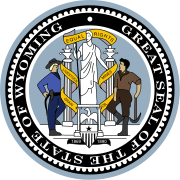 Seal of Wyoming. The state motto, "Equal Rights", refers to Wyoming being the first territory to grant women's suffrage, in 1869
Seal of Wyoming. The state motto, "Equal Rights", refers to Wyoming being the first territory to grant women's suffrage, in 1869
During the beginning of the twentieth century, as women's suffrage faced several important federal votes, a portion of the suffrage movement known as the National Women's Party and led by suffragette Carrie Chapman Catt then Alice Paul became the first "cause" to picket outside the White House. With this manner of protest, suffragists were subject to arrests and many were jailed.[53]
The key vote came on June 4 1919, when the Senate approved the amendment by 56 to 25 after four hours of debate, during which Democratic Senators opposed to the amendment filibustered to prevent a roll call until their absent Senators could be protected by pairs. The Ayes included 36 (82%) Republicans and 20 (54%) Democrats. The Nays comprised 8 (18%) Republicans and 17 (46%) Democrats. It was ratified by sufficient states in 1920, the Nineteenth Amendment, which prohibited state or federal gender-based restrictions on voting. [54]
Oceania
Australia
 South Australian suffragette Catherine Helen Spence (1825-1910). South Australia granted women the vote in 1894.
South Australian suffragette Catherine Helen Spence (1825-1910). South Australia granted women the vote in 1894. Main article: Women's suffrage in Australia
Main article: Women's suffrage in AustraliaThe female descendants of the Bounty mutineers who lived on Pitcairn Islands could vote from 1838, and this right transferred with their resettlement to Norfolk Island (now an Australian external territory) in 1856.[4]
Propertied women in the colony of South Australia were granted the vote in local elections (but not parliamentary elections) in 1861. Henrietta Dugdale formed the first Australian women's suffrage society in Melbourne, Victoria in 1884. Women became eligible to vote for the Parliament of South Australia in 1894 and in 1897, Catherine Helen Spence became the first female political candidate for political office, unsuccessfully standing for election as a delegate to Federal Convention on Australian Federation. Western Australia granted voting rights to women in 1899.[14]
The first election for the Parliament of the newly formed Commonwealth of Australia in 1901 was based on the electoral provisions of the six pre-existing colonies, so that women who had the vote and the right to stand for Parliament at state level had the same rights for the 1901 Australian Federal election. In 1902, the Commonwealth Parliament passed the Commonwealth Franchise Act, which enabled all women to vote and stand for election for the Federal Parliament. Four women stood for election in 1903.[14] The Act did, however, specifically exclude 'natives' from Commonwealth franchise unless already enrolled in a state. In 1949, The right to vote in federal elections was extended to all Indigenous people who had served in the armed forces, or were enrolled to vote in state elections (Queensland, Western Australia, and the Northern Territory still excluded indigenous women from voting rights). Remaining restrictions were abolished in 1962 by the Commonwealth Electoral Act.[55]
Edith Cowan was elected to the West Australian Legislative Assembly in 1921, the first woman elected to any Australian Parliament. Dame Enid Lyons, in the Australian House of Representatives and Senator Dorothy Tangney became the fist women in the Federal Parliament in 1943. Lyons went on to be the first woman to hold a Cabinet post in the 1949 ministry of Robert Menzies. Edith Cowan was elected to the West Australian Legislative Assembly in 1921, the first woman elected to any Australian Parliament. Dame Enid Lyons, in the Australian House of Representatives and Senator Dorothy Tangney became the fist women in the Federal Parliament in 1943. Lyons went on to be the first woman to hold a Cabinet post in the 1949 ministry of Robert Menzies. Rosemary Follett was elected Chief Minister of the Australian Capital Territory in 1989, becoming the first woman elected to lead a state or territory. By 2010, the people of Australia's oldest city, Sydney had female leaders occupying every major political office above them, with Clover Moore as Lord Mayor, Kristina Keneally as Premier of New South Wales, Marie Bashir as Governor of New South Wales, Julia Gillard as Prime Minister, Quentin Bryce as Governor General of Australia and Elizabeth II as Queen of Australia.
Cook Islands
Women in Rarotonga were given the right to vote in 1893, shortly after New Zealand.[56]
New Zealand
Main article: Women's suffrage in New ZealandNew Zealand's Electoral Act of 19 September 1893 made this isolated outpost of the British Empire the first country in the world to grant women the right to vote in parliamentary elections.[4]
Women who owned property and paid rates (usually widows or 'spinsters') were allowed to vote in local government elections in Otago and Nelson from the year 1867 and this right was extended to the other provinces in 1876. Women in New Zealand were inspired to fight for universal voting rights by the equal-rights philosopher John Stuart Mill and the British feminists’ aggressiveness. In addition, the missionary efforts of the American-based Women’s Christian Temperance Union gave them the motivation to fight - and their efforts were supported by a number of important male politicians including John Hall, Robert Stout, Julius Vogel, and William Fox. In 1878, 1879, and 1887 amendments extending the vote to women failed by a hair each time. In 1893 the reformers at last succeeded in extending the franchise to women.
Although the Liberal government which passed the bill generally advocated social and political reform, the electoral bill was only passed because of a combination of personality issues and political accident. The bill granted the vote to women of all races. New Zealand women were not given the right to stand for parliament, however, until 1919. In 2005, almost a third of the Members of Parliament elected were female. Women recently have also occupied powerful and symbolic offices such as those of Prime Minister, Governor-General, Speaker of the House of Representatives, and between 2005, and 2006, all three of these posts were held by women. New Zealand's first chief justice, Sian Elias is also a woman.
Woman suffrage in religions
Catholicism
The Pope is only elected by the College of Cardinals.[57] Women are not appointed as cardinals, so women cannot vote for the Pope.[58]
Hinduism
 American-born Malati Dasi became one of the most vocal suffragettes fighting for equal participation rights for female followers of ISKCON, a Vaishnava branch of Hinduism. Malati Dasi pictured accompanying ISKCON's founder Prabhupada on a morning walk in Vrindavan, UP (India) in 1975.
American-born Malati Dasi became one of the most vocal suffragettes fighting for equal participation rights for female followers of ISKCON, a Vaishnava branch of Hinduism. Malati Dasi pictured accompanying ISKCON's founder Prabhupada on a morning walk in Vrindavan, UP (India) in 1975.
Within Hinduism, ISKCON's founder A. C. Bhaktivedanta Swami Prabhupada openly appreciated, encouraged, and supported his female followers in their diverse roles within ISKCON on par with men, and even recommended two women to be named founding members of ISKCON's highest international ecclesiastical and managerial body, the Governing Body Commission (GBC).[59] Prabhupada also defended the active involvement of his female followers in ISKCON's spiritual and managerial activities from critics, which included some traditional Gaudiya Matha members and other orthodox followers of Hinduism in India.[59]
Towards the end of the 1970s, however, the growth in number and influence of sannyasis (male lifelong celibates) in ISKCON's spiritual and managerial affairs led to greater male domination of the organization, and the consequent segregation, disempowerment, and denigration of women, who were denied access to prominent roles in ISKCON.[60][61] In late 1980s, criticism of the treatment of women within ISKCON and the discrimination against them in the institution's key activities began to take shape in the form of printed articles and women conventions.[62]
In the mid-1990s, Malati Dasi played a leading role in efforts to ensure equality for women in the organization and helped form ISKCON Women's Ministry in 1997, headed by Sudharma Dasi.[62] Malati became a vocal suffragette within ISKCON, which led to her "fiercely debated but historic appointment" as the first female member of the Governing Body Commission of ISKCON in 1998.[60][63][64] Her and Sudharma's presence on the GBC raised the issue of women in the organization for serious discussion at the GBC's annual meeting in Mayapur (West Bengal, India) in 2000, and called for "an apology for the mistakes of the past, recognition of the importance of women for the health of the movement, and the reinstatement of women's participatory rights."[64] The resultant resolution of the GBC acknowledged the importance of the issue and asserted the priority of providing "equal facilities, full encouragement, and genuine care and protection for the women members of ISKCON."[63][64]
Judaism
Women are denied the vote and the ability to be elected to positions of authority in many Orthodox Jewish synagogues and religious organizations.[65][66][67]
Women's suffrage denied or conditioned
 Brunei—Women and men have been revoked the right to vote or to stand for a national legislative election since 1962. Only in local elections are they permitted.[68]
Brunei—Women and men have been revoked the right to vote or to stand for a national legislative election since 1962. Only in local elections are they permitted.[68] Lebanon—Proof of elementary education is required for women but not for men, while voting is compulsory for men but optional for women.[69]
Lebanon—Proof of elementary education is required for women but not for men, while voting is compulsory for men but optional for women.[69] Saudi Arabia—Women were not given the right to vote or to stand for the local election in 2005, although suffrage was slated to possibly be granted by 2009,[70][71][72] then set for later in 2011, but suffrage was not granted either of those times.[73] In late September, 2011, King Abdullah bin Abdulaziz al-Saud, declared that women would be able to vote and run for office starting in 2015.[27]
Saudi Arabia—Women were not given the right to vote or to stand for the local election in 2005, although suffrage was slated to possibly be granted by 2009,[70][71][72] then set for later in 2011, but suffrage was not granted either of those times.[73] In late September, 2011, King Abdullah bin Abdulaziz al-Saud, declared that women would be able to vote and run for office starting in 2015.[27] United Arab Emirates—Limited suffrage (for both men and women), but it gradually expanded in the recent election held in 2011.[74]
United Arab Emirates—Limited suffrage (for both men and women), but it gradually expanded in the recent election held in 2011.[74] Vatican City/Holy See (See above under Women's suffrage#Catholicism)
Vatican City/Holy See (See above under Women's suffrage#Catholicism)
See also
- Anti-suffragism
- Izola Forrester
- List of the first female holders of political office in Europe
- Open Christmas Letter
- Suffrage
- Timeline of first women's suffrage in majority-Muslim countries
- Timeline of women's rights (other than voting)
- Timeline of women's suffrage
- Suffragette
- Women's work
References
- ^ Women's suffrage is more common in UK English, and woman suffrage is more common in US English, as shown by entries in UK and US dictionaries, which usually record only one of these forms, e.g. Collins, New Oxford, American Heritage, Random House, Merriam-Webster. Similarly, the US encyclopedias Encyclopedia Britannica (despite its name a US encyclopedia) and Collier Encyclopedia use only woman suffrage.
- ^ "Education.yahoo.com". Education.yahoo.com. http://education.yahoo.com/reference/dictionary/entry/woman%20suffrage. Retrieved 2011-01-08.
- ^ "Foundingdocs.gov.au". Foundingdocs.gov.au. http://foundingdocs.gov.au/item.asp?dID=8. Retrieved 2011-01-08.
- ^ a b c d e EC (2005-04-13). "Elections.org.nz". Elections.org.nz. http://www.elections.org.nz/study/education-centre/history/votes-for-women.html. Retrieved 2011-01-08.
- ^ a b c d e * Åsa Karlsson-Sjögren: Männen, kvinnorna och rösträtten : medborgarskap och representation 1723–1866 ("Men, women and the vote: citizenship and representation 1723–1866") (in Swedish)
- ^ Chapin, Judge Henry (2081). Address Delivered at the Unitarian Church in Uxbridge; 1864. Worcester, Mass.: Charles Hamilton Press (Harvard Library; from Google Books). p. 172.
- ^ "Uxbridge Breaks Tradition and Makes History: Lydia Chapin Taft by Carol Masiello". The Blackstone Daily. http://blackstonedaily.com/Journeys/cm-lt.htm. Retrieved 2011-01-21.
- ^ p. 374, Rough Crossings (2006), Simon Schama
- ^ Web Wizardry - http://www.web-wizardry.com+(1906-03-13). "Biography of Susan B. Anthony at". Susanbanthonyhouse.org. http://susanbanthonyhouse.org/her-story/biography.php. Retrieved 2011-09-02.
- ^ "Wee, Small Republics: A Few Examples of Popular Government," Hawaiian Gazette, Nov 1, 1895, p1
- ^ Colin Campbell Aikman, ‘History, Constitutional’ in McLintock, A.H. (ed),An Encyclopaedia of New Zealand, 3 vols, Wellington, NZ:R.E. Owen, Government Printer, 1966, vol 2, pp.67–75.
- ^ EC (2005-04-13). "Elections.org.nz". Elections.org.nz. http://www.elections.org.nz/study/education-centre/history/votes-for-women.html#1. Retrieved 2011-01-08.
- ^ "Constitution (Female Suffrage) Act 1895 (SA)". National Archives of Australia. http://foundingdocs.gov.au/item.asp?dID=8. Retrieved 2007-12-10.
- ^ a b c "AEC.gov.au". AEC.gov.au. 2007-08-09. http://www.aec.gov.au/Elections/Australian_Electoral_History/milestone.htm. Retrieved 2011-01-08.
- ^ Mian Ridge. ""Bhutan makes it official: it's a democracy." ''Christian Science Monitor,'' March 25, 2008". Csmonitor.com. http://www.csmonitor.com/World/Asia-South-Central/2008/0325/p04s01-wosc.html. Retrieved 2011-09-02.
- ^ "Newstatesman.com". Newstatesman.com. 2008-07-14. http://www.newstatesman.com/society/2008/07/emmeline-pankhurst-women-cause. Retrieved 2011-01-08.
- ^ Maroula Joannou, June Purvis (1998) The women's suffrage movement: new feminist perspectives p.157. Manchester University Press, 1998
- ^ Gregory Hammond, The Women's Suffrage Movement and Feminism in Argentina From Roca to Peron (U of New Mexico Press; 2011)
- ^ Simon Vratsian Hayastani Hanrapetutyun (The Republic of Armenia, Arm.), Yerevan, 1993, p. 292.
- ^ "постановление "О производстве выборов гласных городских дум, об участковых городских управлениях"". Emsu.ru. http://emsu.ru/ml/view.asp?c=161&p=1. Retrieved 2011-01-08.
- ^ "Constituent Assembly electoral law of 1917". Democracy.ru. http://www.democracy.ru/library/publications/voter/special/el_history/page31.html. Retrieved 2011-01-08.
- ^ Blackburn, Susan, 'Winning the Vote for Women in Indonesia' Australian Feminist Studies, Volume 14, Number 29, 1 April 1999, pp. 207–218
- ^ "The Fusae Ichikawa Memorial Association". Ichikawa-fusae.or.jp. http://www.ichikawa-fusae.or.jp/110/main.htm. Retrieved 2011-01-08.
- ^ "BBC news". BBC News. 2005-05-17. http://news.bbc.co.uk/2/hi/middle_east/4552749.stm. Retrieved 2011-01-08.
- ^ http://www.theatlantic.com/international/archive/2011/10/in-saudi-arabia-a-quiet-step-forward-for-women/247351/
- ^ Saudi monarch grants kingdom’s women right to vote, but driving ban remains in force - The Washington Post
- ^ a b c Alsharif, Asma, "UPDATE 2-Saudi king gives women right to vote", Reuters, September 25, 2011. Retrieved 2011-09-25.
- ^ "Women in Saudi Arabia to vote and run in elections", BBC, 25 September 2011
- ^ Template:See Lowry, 1997
- ^ "85 Jahre allgemeines Frauenwahlrecht in Österreich". Österreichische Nationalbibliothek. http://www.onb.ac.at/ariadne/projekte/frauen_waehlet/index.html. Retrieved 2011-09-01 ..
- ^ a b c P. Orman Ray: Woman Suffrage in Foreign Countries. The American Political Science Review. Vol. 12, No. 3 (Aug., 1918), pp. 469-474
- ^ Report from Denmark in European Database Women in Decision-making.
- ^ Jean-Pierre Maury. "Ordonnance du 21 avril 1944 relative à l'organisation des pouvoirs publics en France après la Libération". Mjp.univ-perp.fr. http://mjp.univ-perp.fr/france/co1944-2.htm. Retrieved 2011-01-08.
- ^ Assemblée nationale. "La citoyenneté politique des femmes – La décision du Général de Gaulle" (in French). http://www.assemblee-nationale.fr/histoire/femmes/citoyennete_politique_de-Gaulle.asp. Retrieved 2007-12-19.
- ^ Patrick Weil. "Le statut des musulmans en Algérie coloniale. Une nationalité française dénaturée" (in French). in La Justice en Algérie 1830–1962, La Documentation française, Collection Histoire de la Justice, Paris, 2005, pp.95–109. http://www.patrick-weil.com/Fichiers%20du%20site/2005%20-%20Le%20statut%20des%20musulmans%20en%20Alg%C3%A9rie%20coloniale%20(Doc.%20fran%C3%A7aise).pdf. Retrieved 2007-12-19.
- ^ Daniel Lefeuvre (26 March 2003). "1945–1958 : un million et demi de citoyennes interdites de vote !" (in French). Clio, numéro 1/1995, Résistances et Libérations France 1940–1945. http://clio.revues.org/document524.html. Retrieved 2007-12-19.
- ^ Kevin Passmore Women, Gender and Fascism, p. 16
- ^ AP (1984-07-02). "AROUND THE WORLD - AROUND THE WORLD - Liechtenstein Women Win Right to Vote". Liechtenstein: NYTimes.com. http://www.nytimes.com/1984/07/02/world/around-the-world-liechtenstein-women-win-right-to-vote.html. Retrieved 2011-01-08.
- ^ God's Playground: A History of Poland, By Norman Davies, Columbia University Press, 1982, p. 302
- ^ Hostages of Modernization: Studies on Modern Antisemitism, 1870-1933/39, By Herbert Arthur Strauss, Published 1993, Walter de Gruyter, p. 985
- ^ "Blogspot.com". Sufragiomujer.blogspot.com. 2004-02-23. http://sufragiomujer.blogspot.com/. Retrieved 2011-01-08.
- ^ Christer Palmquist & Hans Kristian Widberg (2004) (in Swedish). Millenium. Samhällskunskap. Bonniers. p. 317. ISBN 91-622-599-0.
- ^ a b "Runeberg.org". Runeberg.org. http://runeberg.org/nfbo/0225.html. Retrieved 2011-01-08.
- ^ a b "The Long Way to Women's Right to Vote in Switzerland: a Chronology". History-switzerland.geschichte-schweiz.ch. http://history-switzerland.geschichte-schweiz.ch/chronology-womens-right-vote-switzerland.html. Retrieved 2011-01-08.
- ^ Manz, Ev (23 July 2010). "Die Wegbereiterin aller Bundesrätinnen" (in German). Tages-Anzeiger. http://www.tagesanzeiger.ch/schweiz/standard/Die-Wegbereiterin-aller-Bundesraetinnen-/story/23894564. Retrieved 23 July 2010.
- ^ "Around the world; Liechtenstein Women Win Right to Vote". The New York Times. 2 July 1984. http://www.nytimes.com/1984/07/02/world/around-the-world-liechtenstein-women-win-right-to-vote.html. Retrieved 31 March 2010.
- ^ "United Nations press release of a meeting of the Committee on the Elimination of Discrimination against Women (CEDAW), issued on the 14 January 2003". Un.org. http://www.un.org/News/Press/docs/2003/WOM1373.doc.htm. Retrieved 2011-09-02.
- ^ Martin D. Pugh, "Politicians and the Woman's Vote 1914-1918," History, Oct 1974, Vol. 59 Issue 197, pp 358-374
- ^ G.R. Searle, A New England? Peace and war, 1886-1918 (2004) p 791
- ^ "Emmeline Pankhurst – Time 100 People of the Century". Time Magazine. http://www.yachtingnet.com/time/time100/heroes/profile/pankhurst01.html. "She shaped an idea of women for our time; she shook society into a new pattern from which there could be no going back ."
- ^ see fac-simile at An Act to Grant to the Women of Wyoming Territory the Right of Suffrage and to Hold Office. Library of Congress. 10 December 1869. http://memory.loc.gov/cgi-bin/displayPhoto.pl?path=/pnp/ppmsca/03000/&topImages=03000r.jpg&topLinks=03000v.jpg,03000u.tif&title=An%20Act%20to%20Grant%20to%20the%20Women%20of%20Wyoming%20Territory%20the%20Right%20of%20Suffrage%20and%20to%20Hold%20Office&displayProfile=0&dir=ammem&itemLink=r?ammem/awhbib:@field(DOCID+@lit(03000)). Retrieved 2007-12-09
- ^ Van Wagenen, Lola: "Sister-Wives and Suffragists: Polygamy and the Politics of Woman Suffrage 1870–1896," BYU Studies, 2001.
- ^ Stevens et al., Jailed for Freedom: American Women Win the Vote, NewSage Press (March 21, 1995).
- ^ Suffrage Wins in Senate; Now Goes to States. The New York Times. 5 June 1919. http://www.fordham.edu/halsall/mod/1920womensvote.html. Retrieved 2011-17-11
- ^ "AEC.gov.au". AEC.gov.au. http://www.aec.gov.au/Voting/indigenous_vote/indigenous.htm. Retrieved 2011-01-08.
- ^ Markoff, John, 'Margins, Centers, and Democracy: The Paradigmatic History of Women's Suffrage' Signs the Journal of Women in Culture and Society, 2003; 29 (1)
- ^ "How is the Pope elected?". Catholic-Pages.com. 2005-04-06. http://www.catholic-pages.com/pope/election.asp. Retrieved 2011-09-02.
- ^ "Women and the Priesthood". Catholic.com. http://www.catholic.com/library/Women_and_the_Priesthood.asp. Retrieved 2011-09-02.
- ^ a b Knott 2004, p. 301
- ^ a b Bryant 2003, p. 112
- ^ Knott 2004, pp. 301–2
- ^ a b Knott 2004, p. 303
- ^ a b Rochford 2007, p. 140
- ^ a b c Knott 2004, pp. 303–4
- ^ "Manhattan, NY - Rabbi Keeps Off Women from Board of LES Orthodox Synagogue". VosIzNeias.com. http://www.vosizneias.com/63964/2010/09/12/manhattan-ny-rabbi-holds-on-to-keep-women-off-from-board-of-orthodox-synagogue/. Retrieved 2011-09-02.
- ^ "JUDGE DISMISSES LAWSUIT AGAINST SYNAGOGUE - June 23, 2004 - The New York Sun". Nysun.com. 2004-06-23. http://www.nysun.com/new-york/judge-dismisses-lawsuit-against-synagogue/14/. Retrieved 2011-09-02.
- ^ "The Key to Marital Harmony: One Vote Per Couple?". CrownHeights.info. http://www.crownheights.info/index.php?itemid=33955. Retrieved 2011-09-02.
- ^ Comment Details (2007-05-12). "Women still denied voting rights". Newstrackindia.com. http://www.newstrackindia.com/newsdetails/147. Retrieved 2011-09-02.
- ^ "CIA – The World Factbook – Lebanon". Cia.gov. https://www.cia.gov/library/publications/the-world-factbook/geos/le.html#Govt. Retrieved 2011-01-08.
- ^ "Women voters will have to wait until 2009". Citymayors.com. http://www.citymayors.com/report/saudi_elections.html. Retrieved 2011-01-08.
- ^ "At least 2 years wait". Saudigazette.com.sa. http://www.saudigazette.com.sa/index.cfm?method=home.regcon&contentID=2008101218963. Retrieved 2011-01-08.
- ^ Logged in as click here to log out (2008-07-29). "Hello, democracy – and goodbye". Guardian. http://www.guardian.co.uk/commentisfree/2009/feb/24/saudiarabia. Retrieved 2011-01-08.
- ^ "No votes for women in Saudi municipal elections". Reuters.com. http://www.reuters.com/article/2011/03/28/us-saudi-elections-idUSTRE72R65E20110328. Retrieved 2011-09-02.
- ^ "UAE's second election has low turnout". http://www.realclearworld.com.+2011-09-24. http://www.realclearworld.com/news/reuters/international/2011/Sep/24/uae_s_second_election_has_low_turnout.html. Retrieved 2011-09-27.
- Baker, Jean H. Sisters: The Lives of America's Suffragists. Hill and Wang, New York, 2005. ISBN 0-8090-9528-9.
- "Woman suffrage" in Collier's New Encyclopedia, X (New York: P.F. Collier & Son Company, 1921), pp. 403–405.
- Webster's Ninth New Collegiate Dictionary (New York: Merriam Webster, 1983) ISBN 0-87779-511-8
- Åsa Karlsson-Sjögren: "Männen, kvinnorna och rösträtten : medborgarskap och representation 1723–1866" (Men, women and the vote: citizenship and representation 1723–1866) (in Swedish)
- Women in politics
- Women's Suffrage, "A World Chronology of the Recognition of Women's Rights to Vote and to Stand for Election".
- Bryant, Edwin F. (2003), "Hare Krishna Movement", in Laderman, Gary; León, Luis D., Religion and American Cultures: An Encyclopedia of Traditions, Diversity, and Popular Expressions, 3, Santa Barbara, CA: ABC-CLIO, pp. 110–112, ISBN 1-5760-7238-X, http://books.google.com/books?id=9RYs-Z6AdpQC&printsec=frontcover&source=gbs_ge_summary_r&cad=0
- Knott, Kim (2004), "Healing the Heart of ISKCON: The Place of Women", in Bryant, Edwin F.; Ekstrand, Maria, The Hare Krishna movement: the postcharismatic fate of a religious transplant, New York, NY: Columbia University Press, pp. 291–311, ISBN 9780231122566, http://books.google.com/books?id=mBMxPdgrBhoC
- Rochford, Burke E. (2007), Hare Krishna transformed, New York, NY: New York University Press, ISBN 9780814775790, http://books.google.com/books?id=HiD5Enrerv0C
Further reading
- DuBois, Ellen Carol, Harriot Stanton Blatch and the Winning of Woman Suffrage (New Haven and London: Yale University Press, 1997) ISBN 0-300-06562-0
- Flexner, Eleanor, Century of Struggle: The Woman's Rights Movement in the United States, enlarged edition with Foreword by Ellen Fitzpatrick (1959, 1975; Cambridge and London: The Belknap Press of the Harvard University Press, 1996) ISBN 0-674-10653-9
- Kenney, Annie, Memories of a Militant' (London: Edwin Arnold, 1924)
- Lloyd, Trevor, Suffragettes International: The Worldwide Campaign for Women's Rights (New York: American Heritage Press, 1971).
- Lowry, D. (1997) ‘White woman’s’ country: Ethel Tawse Jollie and the Making of White Rhodesia, Journal of Southern African Studies, 23(2), pp. 259–281.
- Mackenzie, Midge, Shoulder to Shoulder: A Documentary (New York: Alfred A. Knopf, 1975). ISBN 0-394-73070-4
- Raeburn, Antonia, Militant Suffragettes (London: New English Library, 1973)
- Stevens, Doris, edited by Carol O'Hare, Jailed for Freedom: American Women Win the Vote (1920; Troutdale, OR: NewSage Press, 1995). ISBN 0-939165-25-2
- Wheeler, Marjorie Spruill, editor, One Woman, One Vote: Rediscovering the Woman Suffrage Movement (Troutdale, OR: NewSage Press, 1995) ISBN 0-939165-26-0
External links
- UNCG Special Collections and University Archives selections of American Suffragette manuscripts
- Parstscape.org, Read a detailed historical record about The Office of the Manchester National Society For Women's Suffrage
- Photo Essay on Women's Suffrage by the International Museum of Women
- Suffrage in Canada
- World Chronology (outdated, but useful)
- Inter-Parliamentary Union: Women's Suffrage
- CIA Yearbook: Suffrage
- Press release with respect to Qatar and Yemen
- "Winning the Vote", international woman suffrage timeline
- FemBio – Biographies of Notable Women International
- Legal Status Of Women In Iowa (1894) by Jennie Lansley Wilson, at Project Gutenberg.
- "Monster Petition" of the Australian state of Victoria
- Photographs of U.S. suffragettes, marches, and demonstrations
- Ada James papers and correspondence (1915–1918) – a digital collection presented by the University of Wisconsin Digital Collections Center. Ada James (1876–1952) was a leading a social reformer, humanitarian, and pacifist from Richland Center, Wisconsin and daughter of state senator David G. James. The Ada James papers document the grass roots organizing and politics required to promote and guarantee the passage of women's suffrage in Wisconsin and beyond.
- Women´s suffrage in Germany – 19 January 1919 – first suffrage (active and passive) for women in Germany
- Suffragettes versus Suffragists – website comparing aims and methods of Women’s Social and Political Union (Suffragettes) to National Union of Women’s Suffrage Societies (Suffragists)
- Suffragists vs. Suffragettes – brief article outlining origins of term "suffragette", usage of term and links to other sources.
- Women in Congress – Information about women who have served in the U.S. Congress including historical essays that cover suffrage.
- Culture Victoria – historical images and videos for the Centenary of Women’s Suffrage
- Woman suffragist, Mary Ellen Ewing vs the Houston School Board - Collection at the University of Houston Digital Library.
Suffrage Basic topics Voting age · Youth suffrage · Right of foreigners to vote · Demeny voting · Women's suffrage · Universal suffrage · Compulsory voting · DisfranchisementBy country Japan · History in New Zealand · United States (Foreigners · District of Columbia · Puerto Rico · 26th Amendment · Women)See also Feminism Women · FemininityConcepts Movement · Theory · Effects on society · Feminism in culture · Film theory · Economics · Feminist sexology · Women's rights · Gender equality · Equality · Matriarchy · Pro-feminism · Anti-feminismHistory SocialWomen's history · Feminist history · History of feminism · Timeline of women's rights (other than voting)SuffrageWavesSubtypes Movements and ideologies (main article) · Amazon · Anarchist · Atheist · Black · Chicana · Christian · Conservative · Cultural · Difference · Eco · Equality · Equity · Fat · Gender · Global · Individualist · Islamic · Jewish · Lesbian · Liberal · Marxist · Material · New · Postcolonial · Postmodern · Pro-life · Radical · Religious · Separatist · Sex-positive · Socialist · Third world · Transfeminism · Womanism · French (subtype rather than country)By country Women's Rights by Country · Feminists by Nationality · China · Egypt · France · Indonesia · Iran · Japan · Nepal · Nicaragua · Poland · Ukraine · United Kingdom · United StatesLists & Indexes Categories:- Elections
- Feminism and history
- Lists by country
- Politics by issue
- Women's suffrage
Wikimedia Foundation. 2010.



